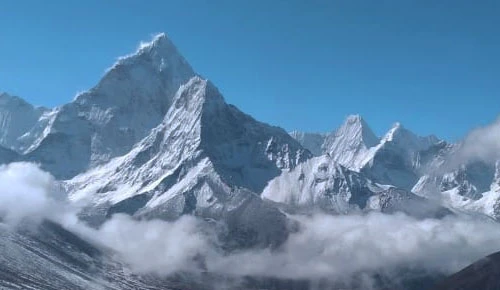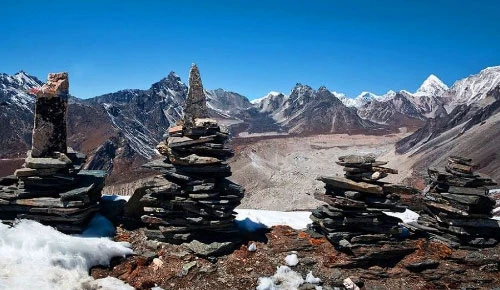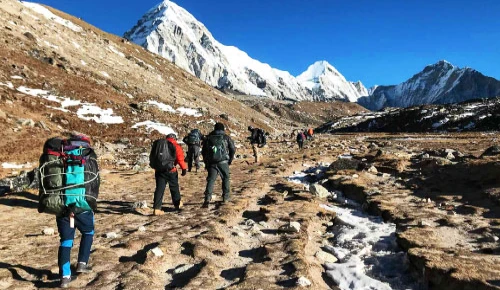How Dangerous is Everest Base Camp Trek
Everest base camp is a popular destination for people who love adventure and mountain climbing. It is located in Nepal's Khumbu region and holds great importance. Many people are attracted to Everest base camp because it is the starting point for climbers who want to reach the top of Mount Everest, the tallest mountain in the world. People who trek can witness the bravery and determination of those who attempt to conquer this incredible mountain.
The region where Mount Everest base camp is located has breathtaking scenery. There are magnificent snow-covered peaks, enormous glaciers, beautiful valleys, and charming villages where the Sherpa people live. Trekking through this area allows you to experience the tranquility and magnificence of the Himalayas. However, it's important to know that the journey to base camp is physically challenging.
The biggest challenge is the high altitude. As you go higher, the air becomes thinner, and it becomes harder for your body to get enough oxygen. This can cause altitude sickness, which includes symptoms like headaches, nausea, and tiredness.It's crucial to take time to acclimatize to the altitude and give your body a chance to adjust.
The trek involves walking on difficult paths, climbing steep slopes, and crossing suspension bridges, which require physical strength and endurance. Despite these challenges, people from all over the world are drawn to the adventure and trekking to Everest Base Camp.

Table of Contents
Physical Challenges of Trekking to Everest Base Camp
Trekking is a tough adventure that comes with many physical challenges. By learning about these challenges and preparing accordingly, you can increase your chances of having a safe and successful trek to Everest base camp. Being aware of the risks and taking necessary precautions will help you enjoy the adventure while keeping yourself out of harm's way. Let's take a closer look at some of these challenges and how they can affect trekkers.
Altitude sickness and its risks
Altitude sickness is a common concern when climbing to higher altitudes. As you go higher, the air gets thinner, and this can cause problems like headaches, nausea, and tiredness. It's important to know the risks and be aware of the signs of altitude sickness to stay safe.
Acclimatization Process and its Importance
Acclimatization is a process that helps your body adjust to the changing oxygen levels at higher altitudes. It involves spending extra days at certain elevations to let your body get used to the conditions. Acclimatization is crucial to reducing the risk of altitude-related illnesses, so it's important to follow the recommended guidelines.
Extreme Weather Conditions and Their Impact
The weather in the Everest area can be unpredictable and harsh. You might experience freezing temperatures, strong winds, snowstorms, and blizzards. It's essential to understand how these extreme weather conditions can affect your trek and make sure you have the right clothing and equipment to stay safe.
Difficult Terrains and Their Challenges
The terrain you'll encounter during the Everest base camp trek can be challenging. You'll have to tackle steep slopes, rocky paths, and narrow trails. It's important to be prepared for this tough terrain and know how to navigate it safely.
Safety Measures and Preparations
While going on a trekking adventure, it is important to know about the risks as well as the necessary safety measures. Safety measures and preparations for tekking are crucial to ensuring a safe and successful trekking experience. Here are some of the safety measures:
- Engage in cardiovascular exercises, strength training, and altitude simulation.
- Build endurance and prepare the body for high altitude.
- Sturdy trekking boots, warm clothing, a good sleeping bag, and a reliable backpack.
- Pack appropriate gear to handle the extreme weather conditions.
- Benefit from their knowledge of the terrain and weather conditions.
- Receive valuable support and assistance throughout the trek.
- Obtain travel insurance that covers high-altitude trekking.
- Have a well-thought-out emergency plan for unforeseen circumstances or medical emergencies.
- Ensure prompt assistance and evacuation when needed.
Common Risks and Dangers
Common risks and dangers at Base Camp include:
Avalanches and Icefalls:
The region is prone to avalanches and icefalls, especially in certain areas with steep slopes and unstable ice formations. These natural hazards can pose a significant threat to climbers and trekkers.
High-altitude Pulmonary Edema (HAPE) and High-altitude Cerebral Edema (HACE):
At high altitudes; decreased oxygen levels can lead to HAPE and HACE. HAPE affects the lungs, causing fluid buildup, while HACE affects the brain, leading to swelling. Both conditions are life-threatening and require immediate medical attention.
Frostbite and Hypothermia:
The extreme cold temperatures at Base Camp can expose individuals to the risk of frostbite and hypothermia. Frostbite occurs when body tissues freeze, usually affecting extremities such as fingers, toes, and the face. Hypothermia is a dangerous condition where the body loses heat faster than it can produce it, resulting in a dangerously low body temperature.
Falling Rocks and Crevasses:
The rugged terrain includes rocky sections and crevasses, which can be hazardous. Falling rocks or ice from above can cause severe injuries, while hidden crevasses present a risk of falling into deep gaps in the ice.
Accidents and Fatalities:
Despite safety measures, accidents and fatalities can occur sometimes. Factors such as unpredictable weather, human error, avalanches, and medical emergencies contribute to the risks. It is essential to be prepared for such incidents and take the necessary precautions.
It's important for trekkers and climbers to be aware of these risks and take appropriate safety measures, including proper acclimatization, hiring experienced guides, and being equipped with the necessary gear and knowledge to navigate the challenges of Base Camp.
Accidents and Fatalities
Accidents and fatalities at EBC have been a sobering reality for climbers and trekkers attempting to conquer the world's highest peak. Here's a brief overview of this topic:
Statistics and Historical Incidents:
Everest Base Camp has witnessed numerous accidents and fatalities over the years. Statistics show that the death rate on Mount Everest stands at around 2-3%, making it a perilous endeavor. Several high-profile incidents, such as the 1996 Everest disaster and the 2014 avalanche, have garnered significant attention and highlighted the dangers associated with the climb.
Causes of Accidents and Fatalities:
Several factors contribute to accidents and fatalities at base camp. Harsh weather conditions, including sudden storms and extreme cold, pose significant risks. Avalanches and icefalls are common hazards, particularly in the treacherous Khumbu Icefall. Altitude sickness, such as high-altitude pulmonary edema (HAPE) and high-altitude cerebral edema (HACE), can also lead to critical situations.
Lessons Learned from Past Tragedies:
Tragic incidents at Everest base camp have prompted valuable lessons for climbers and the mountaineering community. The importance of proper acclimatization and physical fitness has been underscored. Communication and coordination among climbers, guides, and support teams are crucial for managing emergencies effectively. Additionally, improved weather forecasting and early warning systems have been implemented to mitigate risks.
Efforts to Improve Safety and Minimize Risks:
In response to the inherent dangers of Everest base camp, various initiatives have been undertaken to enhance safety. Mountaineering organizations and expedition operators have implemented stricter regulations and screening processes to ensure climbers have sufficient experience and training. Additionally, increased focus on education and awareness programs has aimed to educate climbers about potential risks and the importance of responsible mountaineering.
Despite the risks, efforts continue to be made to strike a balance between adventure and safety at Everest base camp. The aim is to provide climbers with the opportunity to conquer their dreams while minimizing the potential for accidents and fatalities.
Tips for a Safe and Successful Trek
Here are a few tips for a safe and successful trek:
- Choose the right time for the trek: Consider weather conditions and crowd levels during different seasons.
- Use proper acclimatization strategies: Take rest days at certain altitudes and gradually ascend to higher altitudes.
- Stay hydrated and eat a healthy diet: Drink plenty of water and eat nutritious meals to maintain energy levels.
- Follow safety guidelines and instructions: Adhere to instructions from experienced guides and trekking agencies.
- Stay on designated trails and avoid risky shortcuts.
- Be aware of potential hazards like avalanches and crevasses.
- Prioritize your safety and listen to experienced professionals.








